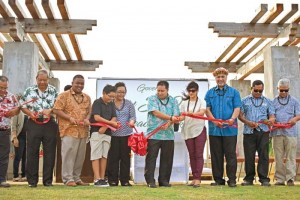Inos Peace Park unveiled Friday

Gov. Ralph DLG Torres, sixth left, and acting Assistant Secretary for Insular Areas Nikolao Pula, third right, lead the ribbon cutting of the Gov. Eloy S. Inos Peace Park last Friday. (Jon Perez)
Gov. Ralph DLG Torres led the ribbon cutting and unveiling of the Gov. Eloy S. Inos Peace Park last Friday—the completion of a project that took close to two decades, five administrations, and almost $30 million to complete.
The park, converted from a circa World War II dump, will be open to the public on April 1.
Acting Assistant for Insular Affairs Nikolao Pula represented the Department of the Interior-Office of the Insular Affairs at the unveiling. DOI funded the parks closure and conversion.
Torres said it was a monumental and emotional day for all the people who were present, especially for the family of the late governor Inos, who in June 2015 led the groundbreaking ceremony to start the conversion of the former dump into a public park.
Inos passed away later that year without seeing the completion of the project that he also helped achieve. Former governors Pedro Tenorio, Juan N. Babauta, and Benigno R. Fitial, were also instrumental for the project.
“The late governor [Inos] also spent a lot of time in order to make sure the project is funded. He worked closely with OIA, with then still director Nik Pula and Assistant Secretary Esther Kia’aina,” said Torres.
“Every administration in the past, including governor Inos looked forward to the Puerto Rico dumpsite being transformed into a family park. Now, we see this landfill transformed to what it is today.”
The close partnership between the federal and local governments is a testament to the project’s completion, Torres added. “We can achieve something great. It may cost a lot or a little bit more but the collaboration in time is the result that we’re seeing today.”
Pula congratulated everyone who had played a part in completing the development of the park. “This is the largest infrastructure funded by OIA in the CNMI, costing $29 million. It is 19.5 acres and 80 feet high.”
He said the site of the former municipal dumping ground for over 50 years could no longer be seen. Thanks to OIA funds, the park project was completed after just 22 months.
“Now Saipan has an environmental friendly attraction that is adjacent to the American Memorial Park, which residents and tourists can enjoy,” said Pula.
“The waters of the Saipan lagoon, with fish and corals, provides greater protection for the entire island for generations to come. It also gives you beautiful scenery overlooking Managaha Island and Mt. Tapochau.”
Capital Improvement Projects project manager Elizabeth Balajadia said that Friday was also the dump’s regulatory closure date.
She said the converted park complies with federal regulations “of providing the mechanism to capture all the gases such as methane produced during the natural decomposition of wastes and providing structures such as liners and drainage systems.”
The park has a 33-percent slope; installation of gas control systems located in various sections; and has walls, ditches, and outlets that make up the drainage system.
“This is a project of preserving our environment, supporting our eco-tourism, protecting our greatest natural resources—air, land, and water. This is a project that satisfies the landfill closure and a conversion of the soft use of the land…We recognize all hardworking individuals that madke this park a success.”
A passive park, also known as low intensity recreation, is an area that highlights the open spaces of the facility, allowing the preservation of the natural habitat. It usually involves low-level development of benches, picnic areas, and trails.



























